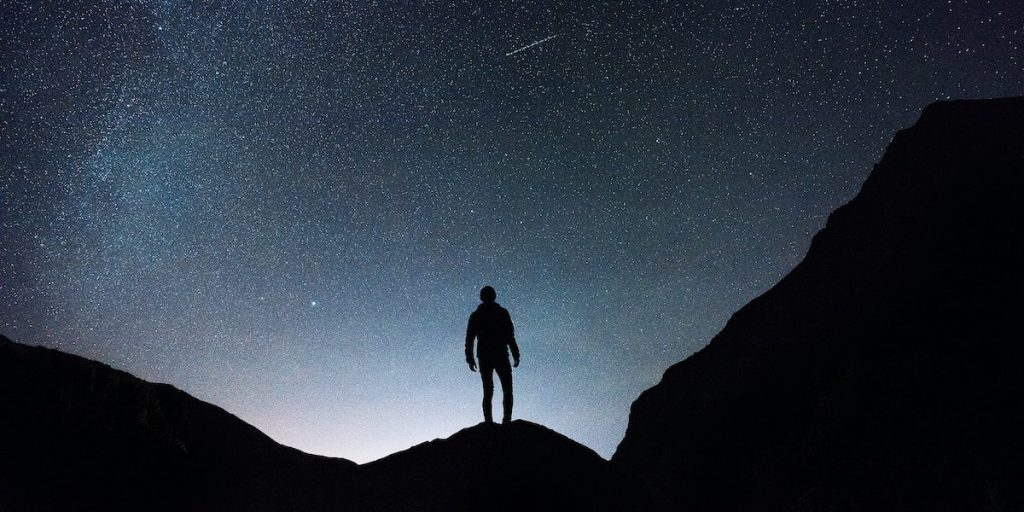READ ON TO DISCOVER:
- What to do during the first 100 days of any relationship
- How the eight phases of the customer journey shed new light on our personal lives
- Why we should reclaim technology’s ability to make us feel more connected
Joey Coleman is an award-winning speaker and business consultant, and the author of the bestselling book Never Lose a Customer Again: Turn Any Sale into Lifelong Loyalty in 100 Days. Jordan Harbinger recently hosted him on The Jordan Harbinger Show to discuss the life-changing value of relating better to our customers, no matter what we’re industry we’re in.
This conversation has been edited and condensed. To listen to Joey and Jordan’s full conversation, click here.
Jordan: You’ve developed your narrative skills as a criminal defense attorney, advised the council of Fortune 500 companies, and worked at the White House, the Secret Service, and the CIA. You’ve also consulted for places like NASA, Whirlpool, the World Bank, and Zappos on customer experience. Why do NASA and the World Bank care about a customer experience?
Joey: Everyone has customers. With both NASA and the World Bank, I tried to create remarkable experiences in their product offerings. NASA had this program called the Explorer School program, where they teach kids in rural communities about science and math. So we helped them create some great experiences for teachers to present in their schools.
For the World Bank, they do research on a big topic for years, and then publish an annual report. They brought me in to help make an annual report that people actually wanted to read. If more people read the annual report, then more people support the World Bank and their efforts. If more people learn about science and math, NASA has astronauts and scientists for the future. Regardless of what kind of job you have, there are people that you serve—and if you make their experience better, they will think more highly of you.
Trending: How to Transform Daily Habits into Life-Changing Rituals
Jordan: So who does the CIA see as their customer? Are you able to even comment on that?
Joey: The CIA has a lot of customers, the people who are going to read the intelligence they produce: the military, operatives in foreign countries, foreign countries [themselves], officials on the Hill or the people in the White House. They are trying to make sure that their analysis and observations get seen, read, and followed by the folks who can act on that information.
“Regardless of what kind of job you have, there are people that you serve.”
I was listening to the very first episode of your show, where you were talking to Mark Geragos, and he said, “To be a good trial lawyer, you need to be a constant student of human nature.” Every job I’ve ever had is about human nature. The things that I learned were about why humans do the things they do, and how we can make them do the things we want them to do.
Jordan: No matter where you are, in any organization, you have customers. You just need to expand the definition of what you think your customer is or looks like. Your methodology is all about the first 100 days of a customer life cycle—tell us what that really means.
Joey: The typical business is going to lose somewhere between 20% and 70% of their new customers before they reach the 100-day anniversary. So this time period, right at the beginning of the relationship, is the most important time period in the entire relationship. It’s where first impressions are made, where first experiences are had. That foundation that you lay early on determines whether or not you’re building on something that is solid, and strong, and firm.
If you get to day 101, in the typical business, you’re going to stay for five years. So if you care about what happens at the beginning, customers will stay longer. This can be applied to personal relationships as well—if we care about establishing a really good relationship at the beginning of the interaction, that fosters longevity. What’s interesting is that most companies are not nurturing that beginning at all—they’re designed to push you to the next upsell, not to make you feel welcomed.
“This can be applied to personal relationships as well—if we care about establishing a really good relationship at the beginning of the interaction, that fosters longevity.”
Jordan: That’s my experience with every internet marketer ever.
Joey: Absolutely. People have become so jaded because of how the typical business operates. And frankly, that’s part of the reason I wrote Never Lose a Customer Again. I’m on a mission to raise the bar for customer experience on the planet. I think the bar for customer experience right now is lying on the ground. We live in an era where people have the ability, courtesy of technology, to be more connected than at any other time in human history, and yet people feel more disconnected than at any other time in human history. I want to get us away from being skeptical that sharing our email means we’re going to be spammed. Instead, let’s cultivate an environment where if somebody is providing value, giving them your email is a good use of your private information, because they’re going to respect it.
“We live in an era where people have the ability, courtesy of technology, to be more connected than at any other time in human history, and yet people feel more disconnected than at any other time in human history.”
Jordan: Once you go down the road of treating people like numbers, the volume [game] is always secondary to whether or not people actually enjoyed the experience. If you focus on whether or not people enjoy the experience, it’s a different type of work.
Trending: 5 Reasons Life Gets Better After Your 40s
Joey: Exactly. If you are in a business and you don’t know how many relationships you’re losing, that has the potential to kill your business. I think it’s the biggest problem in business and personal relationships today—we’re not paying attention to the relationships that we claim are important to us. There are so many businesses that say, “Oh, we treat you like family,” and the first thing they do when you become a customer is assign you a customer number. I understand that businesses and organizations need to keep track of their customers, but it should be directed to the philosophy of, “What kind of relationships do you want to have?”
“We’re not paying attention to the relationships that we claim are important to us.”
Jordan: You’ve broken this down to the eight phases of the customer journey. Let’s go through them.
Joey: The first phase is Assess. This is where the customer considers whether or not they want to do business with you. In a business setting, this is the marketing and sales function, trying to convince people that you’re a good choice for them. In a more personal context, this could be trying to figure out, “Is this somebody I want to exchange numbers with? Get a business card from? Continue the conversation after today?”
Then we move to phase two—Admit. This is where, in a business context, the individual admits that they have a problem that they believe your product or service can help them with. So they sign up for your service, they buy your product, whatever it may be. In a personal context, it might be where they say, “I’d like to continue a conversation with this person. Let’s exchange numbers, and meet up at some point in the future.”
The third phase, Affirm, can also be referred to as “buyer’s remorse.” What brain science shows us is that right after making a purchase or starting a new relationship, the brain fills with dopamine, and we’re excited—we see the possibility of what is to come. But, almost as quickly as that dopamine coats our brain, it starts to recede. As it recedes, those feelings of joy, euphoria, and excitement are replaced by feelings of fear, doubt, and uncertainty: “What if this doesn’t work out the way I’d hoped?”
So what do we do to counter that? In the typical business setting, the business is high-fiving and celebrating, while the customer is going, “I wonder if this is going to work out… If it goes bad, am I going to be able to get my money back?” That gap between the high emotional state of the person doing the selling, and the low emotional state of the person who made the purchase, needs to be closed.
We then come to the next phase, which is Activate. This is the unboxing experience, getting your product for the first time. What are you doing to make it different from any other experience they’ve had? In a personal context, this is like a first date, or the first time you meet up and hang out together. That first experience is going to set the foundation for the relationship to come.
“That first experience is going to set the foundation for the relationship to come.”
Then we move into the phase where usually most relationships fall apart, whether personal or business—the Acclimate phase. This is where the other person is getting used to interacting with you. For a new customer, you need to hold their hand, and show them what comes next.
[The next phase], Accomplish, is a really interesting one. It happens when the customer achieves the goal that they had when they originally decided to do business with you. Most businesses don’t pay attention to this—they sell the product or service without ever asking the customer, “What are you hoping to use this for?” For example, say you’re going to Nordstrom and buying a shirt. Let’s pretend that I’m the sales person, and I say, “Mr. Harbinger, what is this shirt for?” And you say, “I’m planning to wear this to my cousin’s wedding later this summer.” Imagine if in September, you got a note from that sales rep at Nordstrom that said, “Hello, just want to check in and make sure that the shirt looked as good on you at the wedding as it did in the store. Hope you had a fantastic day with your cousin—we look forward to serving you again in the future.” A couple of things would happen: number one, you would be astounded. You would probably also say, “Man, the next time I need a shirt, I’m going back to Nordstrom, because they know me, they like me, and they take care of me.”
Trending: 5 Simple Strategies for Persuading Anybody
Next we move into the Adapt phase. Now that they’ve accomplished what they want, and now they’ve become loyal to you and your brand, they are only going to do business with you going forward.
Then we move to the final phase, phase eight: Advocate. When somebody starts to advocate for your brand, they’re a raving fan. They’re referring their friends, their colleagues, their family members. Most businesses try to jump to this stage too early—they ask for referrals, and they try to rush the relationship. To me, this is the equivalent of going on a first date, and right after you order the entrée, saying, “So, should we schedule a time for me to meet your parents?” It’s like, “Wait a second, I’m not even sure if I’m staying through dessert.”
So customers have the chance to go through these eight phases, our relationships have the chance to go through these eight phases—but every human being has to stop and spend at least some amount of time in each one before they can transition to the next.
Ready for more big ideas like this? Join the Next Big Idea Club today!





























